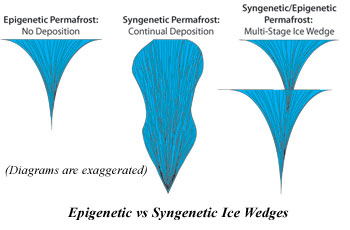
Epigenetic permafrost is formed in soils already has been deposited by wind, water, and/or gravity through the thousands of years of geological action, and after are subjected to a colder climate causes freezing and creates permafrost. Syngenetic permafrost is the process where soil freezes and becomes permafrost occurs as the soils are being emplaced by wind, water, and/or gravity. The
segregate ice and other ice features that are created at the base of the active layer can become captured and will then exist through out of the depth of the syngenetic permafrost layer. With epigenetic permafrost, the ice features will be concentrated at the top portion of the soil layer.
Ice wedges, in epigenetic permafrost, will have a typical wedge shape as seen in the diagram. In syngenetic permafrost, ice wedges will have an atypical shape. With syngenetic permafrost, if the deposition is continual and without large climate change events, the ice wedge will elongate as the top of ground surface and permafrost rises. If the deposition varies with pace and/or the climate changes for a period of time, the ice wedges will look truncated and stacked, and is termed multi-stage wedges in the diagram. For example, imagine an ice wedge developing during a cold, steady depositional period, and then a climate change event happens where the ice stops growing due to warming. This event will truncate the ice wedge, and when conditions returns to cold another ice wedge will start to develop. The diagrams are exaggerated and simplified, where actual ice wedges will not look perfectly shaped as cracking does not happen in the center of the wedge every time. The tunnel primarily contains syngenetic ice wedges, where for several the type is unknown. Several ice wedges are multi-stage looking ice wedges. However, the ice wedges are truncated by a thermal erosion event that took out the tops of the ice wedges, or possibly the centers of a large continual deposition ice wedges. The top portions of the ice wedges cannot be seen within the tunnel, so it is unknown which type of syngenetic ice wedge it is.
The Permafrost Tunnel contains syngenetic permafrost. Due to the syngenetic nature of the permafrost makes the tunnel a time capsule throughout the last 40,000 years. The deposition of the soils through wind and water action was very slow, and through out this time flora and fauna existed on the ground surface. Eventually the flora and fauna were buried and incorporated within the permafrost where it has been kept frozen ever since. There are many exposures of bones and plants along with ice features in the tunnel that can tell us a lot about the past climate and its changes through the last 40,000 years.